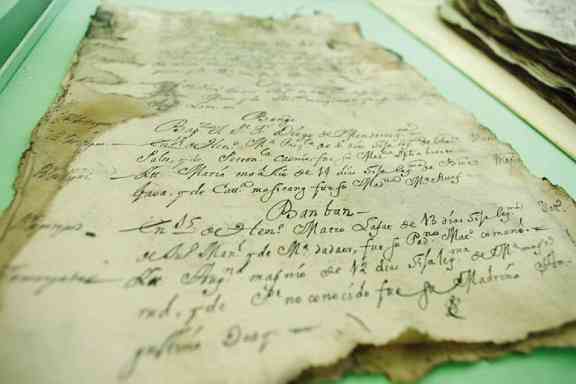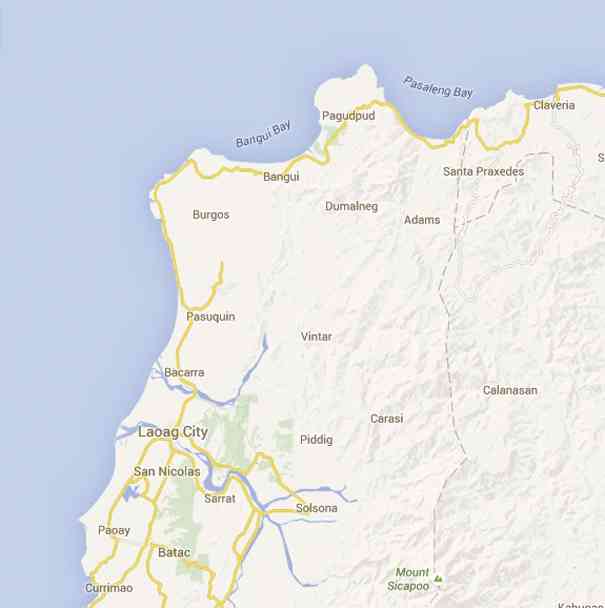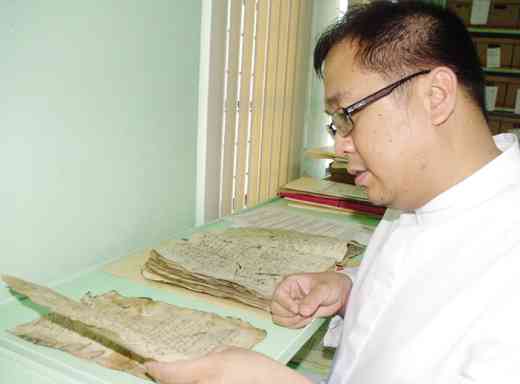‘Lando’ unearths key in search for lost towns of Ilocos Norte

AN 18TH CENTURY baptismal record shows clues to the search for Ilocos Norte’s lost towns. PHOTOS BY LEILANIE ADRIANO

Little did Agustin and Santos know that the oldest baptismal record so far in the province, dated 1702 to 1759, that they found, contains what could be proof of the province’s lost towns.
The 313-year-old, three-inch thick pile of documents that could rewrite the history of Ilocos Norte and shed light on the search for its lost towns, however, was soaked in floodwater.
Five years ago, Fr. Ericson Josue, a native of Pasuquin town, stumbled on the story of these lost towns—Bangbang, Adang and Vera in northern Ilocos Norte—during a study trip in Spain, where he took Licentiate in Sacred Theology at the University of Navarre.
That time, Josue said, he found pieces of evidence on Ilocos Norte’s lost towns. But his research on the lost towns was stalled when he returned to the Philippines as he assumed the post of seminary formator at the Immaculate Conception School of Theology in Vigan City.
Article continues after this advertisementNow that Josue is back in Ilocos Norte as the archivist and curator of the diocesan museum and chair of its heritage committee, he said his longing to find where these lost towns once thrived prompted him to search old records at the diocesan archives.
Article continues after this advertisement‘Bacarra Box 1’
Before he left the country for Spain in 2010, Josue said he saw the “Bacarra Box 1” containing 1702 baptismal entries from the towns of Bangbang, Adang and Vera.
“When I came home, I opted to write an article with the hope that it will later on become a book about these lost towns. So I tried to look again for this 1702-1759 book [of records], but even the box was missing. So I had to ask everyone about this ‘Bacarra Box 1’ and no one could tell me where it was,” he said.
He also searched at the newly established Museo de Bacarra, where it was earlier thought that the missing box and several artifacts may have been taken.
“There are old baptismal and canonical books there but those [dated back to the] 1800s. These were not the [documents] we were looking for,” he said.
While searching for these old manuscripts, Josue said he visited the University of Santo Tomas in Manila to look at microfilms from the Diocese of Laoag.
“I had to check on the 1702 documents and the information [I was looking for] was there… So, [I told myself] if ever we cannot locate anymore the original [documents], at least the information is stored in the microfilm, including a photocopy of the original,” Josue said.
A blessing
But Lando’s wrath proved to be a blessing to Josue’s search for the original documents.
Earlier in September, a janitor at the Bishop’s Residence told Josue that some documents he was looking for may be in the bodega. They started checking the warehouse but it was only recently that the janitors found the documents, although soaked in floodwater.
The manuscripts, according to workers at the Bishop’s Residence, were partly eaten by termites so these were taken out of the archives section.
“To them, that was the best solution to the termite problem. But unknowingly, what was done was the worst move [because] the Bacarra Box 1 manuscripts had been soaked in floodwater,” said Josue.
With the renewed interest shown by the Diocese of Laoag in preserving the church’s history, the diocese’s archives section is being reorganized to preserve these documents.
“I hope that after drying the old manuscripts, I could proceed with my documentation on the lost towns of Bangbang, Adang and Vera. This is saving their stories from … oblivion and showing guideposts for tomorrow’s generation,” said Josue.
He said his initial research led him to clues where Bangbang may have been located—a valley near the Banban River in Bangui town.
“There is a cove where the windmills (Bangui wind farm) are [located] and its terrain possibly speaks of a good civilization because there is a river and it [faces] the sea. If you go to the center of the barangay (Banban), there is a forest and church ruins inside,” he said.
In the 1860s, Josue said there was an attempt to revive the town.
“I found a report at the national archives [regarding] a petition of some natives to reestablish the town of Banban and give it a new name as the town of Vives in honor of then civil governor Estanislao Vives. The request, however, did not prosper due to [the shortage] of population that may qualify the proposed town’s declaration,” he said.
Pirate attacks
He said a document he found dating back to the 1860s claimed the area was abandoned because of pirate attacks, forcing people to move to parts of Bangui.
Old residents also confirmed Josue’s findings, saying their ancestors were warning them about going to the ruins in the middle of the forest because of the presence of tirong (pirates) in the area.
Josue said when he and a group of archeologists visited the area, they found a fence and ruins of a church.
“People are saying there is also an old well in the vicinity. When I was in Valladolid, Spain, I found a document dated 1762 on the discovery of an image of the Sto. Niño made of ivory that they discovered in the area. This was reported to the Diocese of Nueva Segovia. This means there could have been a convent there,” he said.
Bangui Mayor Diosdado Garvida said the local government and residents of Banban are aware of the importance of the ruins to the province’s history.
Garvida has asked the town council and other local government agencies to seek the help of the National Museum so it can send a team of archeologists to study the area. He said historians should help disseminate the story about the significance of the place, which is now a private property.
Josue said he is still gathering and validating information as to where the lost towns of Adang and Vera were once located.
Citing old reports, Josue and some historians theorized Adang may have flourished in the town of Adams while Vera may be found near that town.
Josue said his research showed that the towns of Bangbang, Adang and Vera, including Bangui, were founded by an Augustinian friar named Benito Salazar.
“Based on reports from the Augustinian Archives in Valladolid, Spain, of the three satellite churches of Bangui, Adams or Adanes (the people of Adang) had the biggest. But [the church] is not there anymore,” he said.
No church ruins
Josue said he went to Adams town two years ago but failed to find any church ruins.
He said he had yet to find clues on the possible location of Vera but UST history professor Regalado Jose had told him that within Bangui and near the village of Banban is a mountain peak called “Vera.”
“Probably, that mountain peak used to host the town of Vera,” Josue said.
